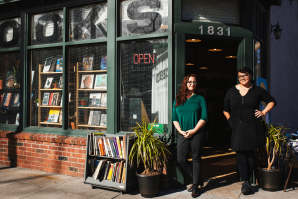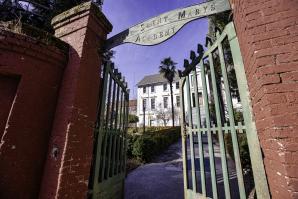Lial Jones sits in a room that didn’t exist when she arrived to lead the Crocker Art Museum nearly 25 years ago.
Jones, who is the Mort and Marcy Friedman director and CEO for the museum, announced recently that she’ll retire at the end of this year. In her tenure, she’s overseen the expansion of both Crocker’s collection and the museum itself. That includes the area of the museum that Jones’ office is located in, a 100,000-square-foot building that opened adjacent to the old museum in 2010.
Transformation is what Jones came to the Crocker to do, she says, but this wasn’t just about building a building.
“It’s about how to take a museum that has some really great features but isn’t particularly embedded into the community or serving the community as much as I thought it should be … and transforming it and trying to make it much more integrated to the fiber of the community,” Jones says.
Where Jones came from
Jones arrived at the Crocker in 1999. She’d previously worked at the Delaware Art Museum, where visitors included people like then-Senator Joe Biden, who ran auctions for it.
“You’d see him,” Jones says. “Delaware’s a very small state. You’d see all your elected officials.”
The Crocker hired Jones after a national search. It’s now in a similar process to find her replacement.
“She came with a vision,” said Megan Van Voorhis, director of convention and cultural services for the city of Sacramento, which owns the museum. This vision was about creating “a world-class art museum,” Van Voorhis adds.
“It’s one thing to have a vision, it’s another thing to be able to influence other people to buy into that vision and ultimately see what we’ve realized,” Van Voorhis says.
A lot has happened at the Crocker, even into recent years.
The Crocker is an institution in Sacramento that dates to 1885, though the exhibits have evolved considerably over the years. Some recent changes came after the 2020 murder of George Floyd, which spurred a reckoning in the art world to include a more diverse array of artists.
Crocker board member and donor Simon Chiu, who didn’t respond to a request for comment for this story, has been instrumental in helping bolster the museum’s representation of Black artists. But some credit for Crocker’s commitment to diversity could also be due to Jones, who is open about both her identity as a lesbian and how it relates to her belief in diversity in the art world.
Lial Jones led the museum through the pandemic, which caused an
11-month closure. (Photo by Graham Womack)

“I’ve grown up in museums. I’ve worked in museums for 50 years; I started working in museums before I had my driver’s license,” Jones says. “Seeing myself in a museum was really important, and I transfer that to other people seeing themselves in the museum is really important. So it’s been a longstanding priority.”
Diversity is not just about what’s on display, either.
“We’re very active programmatically,” Jones says. “We do specific programs for every segment of population. We’ve done programs for expectant mothers, and we’ve done seances. So I like to say we do pre-birth to post-death programming.”
Recent struggles and the road ahead
Like many organizations, the Crocker struggled with the COVID-19 pandemic, which spurred the museum to close for 11 months.
“We were closed for a very, very long time,” Jones says. “And that makes it hard. I mean, we had certain exhibitions that we had to reschedule four times.”
The museum faced a large financial hole, temporarily losing a third of its membership — who had memberships solely because it provided free entry to the museum, Jones explains. While membership has rebounded in the three years since the Crocker was able to reopen, there’s still work ahead.
“It’s hard to get everything back firing on all cylinders,” Jones says. “And we’re pretty close. So whoever comes in, I’m hoping by the end of the year, we’re pretty much there.”
Other possibilities exist for Jones’ successor.
The museum sits tucked at 3rd and O streets at a western part of downtown, with Interstate 5 running directly west of the museum and separating it from the Sacramento River. There was talk approximately 20 years ago of capping the highway, which might help connect the museum to the riverfront, though Jones says the cost estimates back then were over $1 billion.
Still, it’s not inconceivable the city and local leaders could revive these discussions at some point in the future, with riverfront revitalization a longstanding area of focus.
Beyond this, prior to the pandemic, the city and the Crocker discussed building an art park on a plot of land adjacent to the museum. Van Voorhis says that land “was donated to the city for the benefit of the Crocker as a part of that” and that there’s still opportunity going forward to determine what the benefit will now look like.
“When you think about just the downtown overall and how we’re evolving post-pandemic and post this new sort of norm in terms of work, I think we’re going to need arts and culture more than ever,” Van Voorhis says.
But for all the things that haven’t happened, there’s so much more that has happened during Jones’ tenure at the Crocker.
“There isn’t anything about the museum that hasn’t changed,” Jones says. “Honestly, the museum when I got here was not in particularly good shape financially. A little under 100,000 visitors a year.”
She continues, “The museum is now seen as one of the leaders in the art museum field in North America, certainly in the United States, which is good because the museum’s poised to get a really good director by reputation.”
It’s all about the transformation Jones helped to bring about and its deeper integration into the community.
“We’ve done a pretty good job of that,” Jones says. “There’s still a lot more to do, and that’s what the next person can do.”
Stay up to date on business in the Capital Region: Subscribe to the Comstock’s newsletter today.
Recommended For You

Art Exposed: Doug Winter
Elk Grove photographer creates images exploring perception and memory through the lens of visual impairment
After suffering a stroke in his right eye in 2012, Elk Grove resident Doug Winter, a trained commercial photographer, began to think differently about sight and perception.

The Great Circle of the Book
OPINION: Independent bookstores are the secret lifeblood of local culture
Independent Bookstore Day is April 27 this year. The owner of one of Sacramento County’s many independent bookstores lets us in on the unique purpose they serve in their respective neighborhoods.

Art Exposed: Muzi Li Rowe
This mixed media artist and photographer explores culture through defunct technology
Whether it’s layers of tiny microchips or rows of dead batteries, each work in Muzi Li Rowe’s Magical Thinking series is like peering into a tiny museum where the most microscopic parts of now-defunct personal technology devices, from old Nokia flip phones to disposable cameras, become individual hallmarks of consumer culture.

Grass Valley Museum Tells Untold History of Women During the Gold Rush
Industrious nuns, international stars and well-educated orphans
In a county known for its wealth of Gold Rush-era museums, undoubtedly some of the most compelling stories from that time reside at a former orphanage hidden within the 160-year-old walls of the Grass Valley Museum.

Art Exposed: Maren Conrad
Meet the Sacramento muralist and designer who creates joyful spaces for women
Maren Conrad reflects on her iconic Sacramento murals and her latest project, the Jacquelyn.



